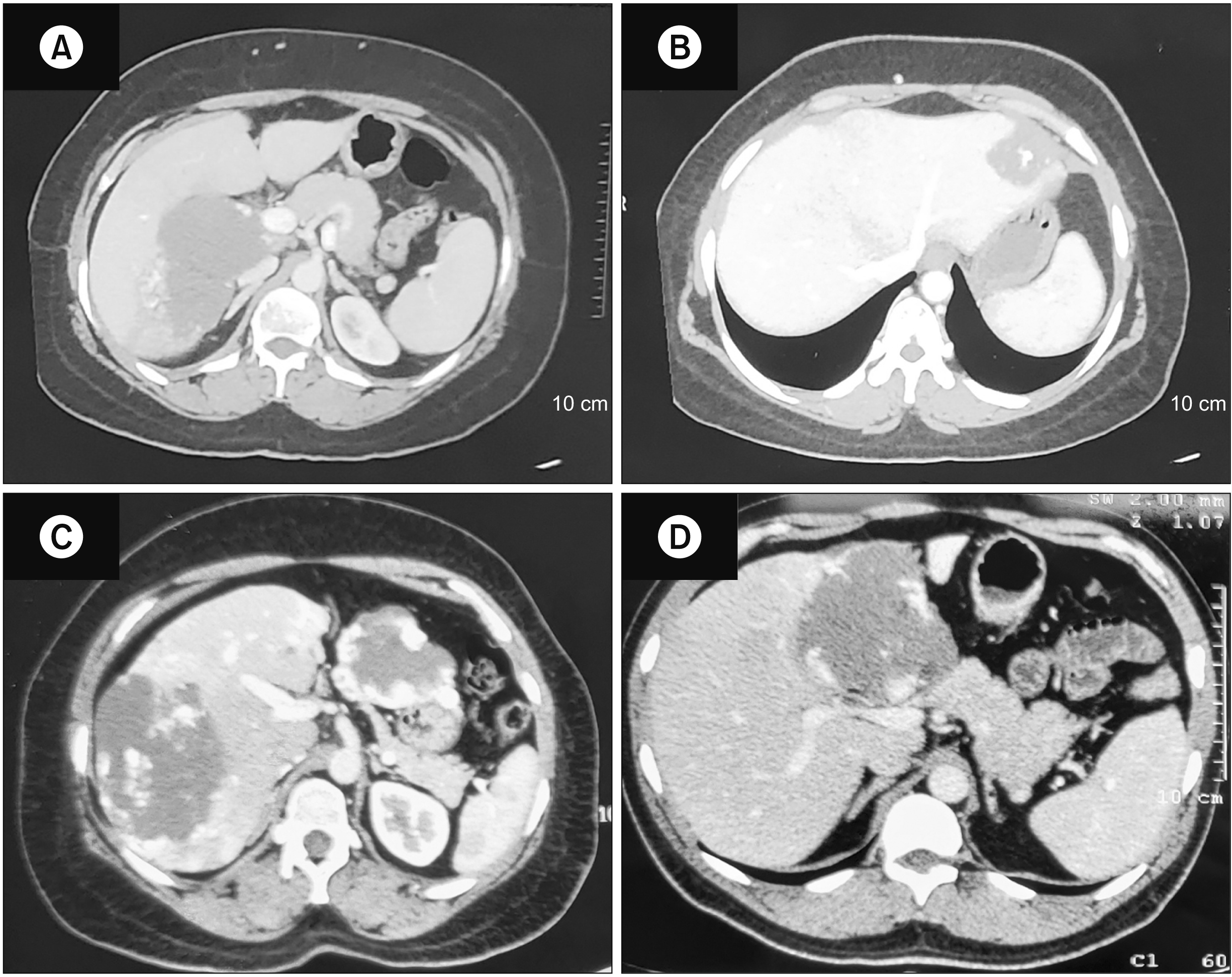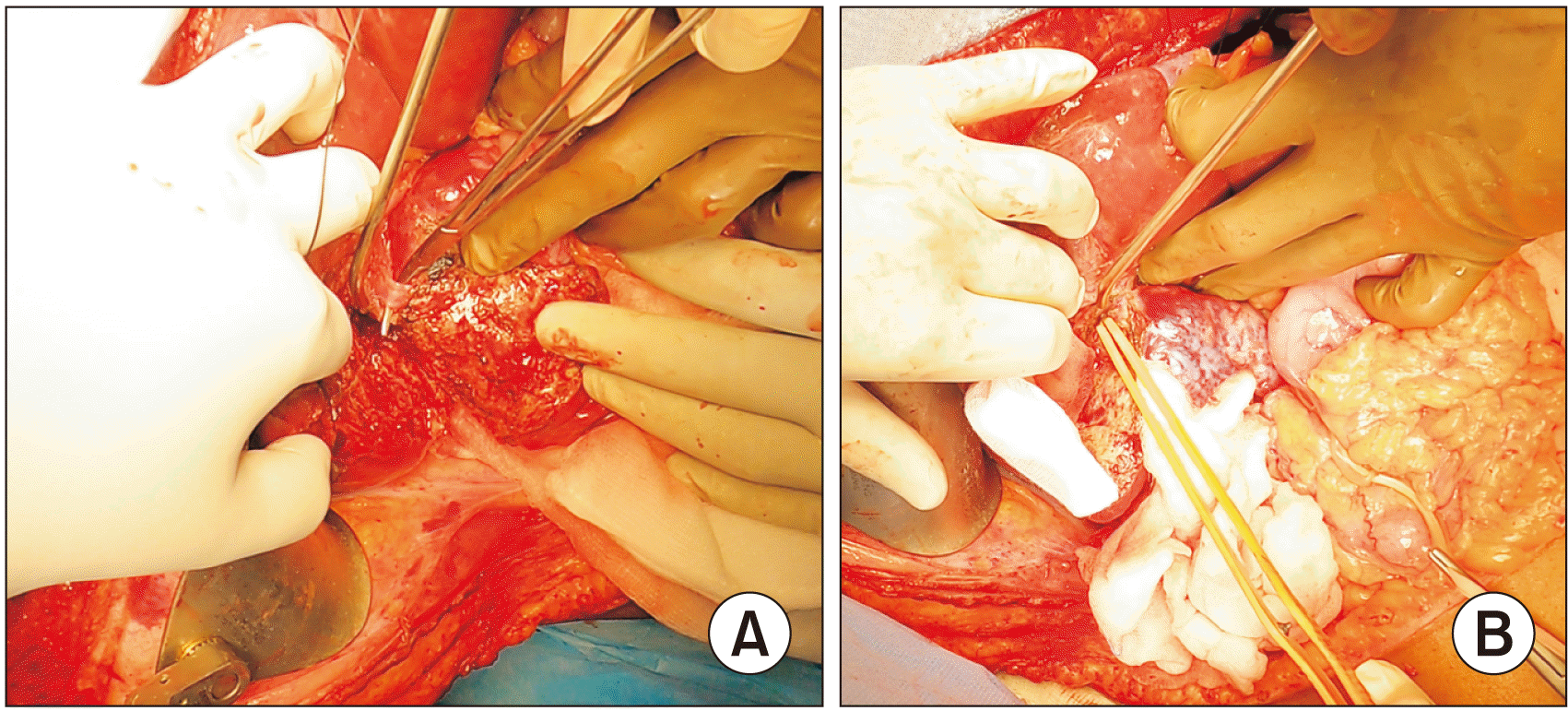1. Zhou JX, Huang JW, Wu H, Zeng Y. 2013; Successful liver resection in a giant hemangioma with intestinal obstruction after embolization. World J Gastroenterol. 19:2974–2978. DOI:
10.3748/wjg.v19.i19.2974. PMID:
23704832. PMCID:
PMC3660824.
2. Caseiro-Alves F, Brito J, Araujo AE, Belo-Soares P, Rodrigues H, Cipriano A, et al. 2007; Liver haemangioma: common and uncommon findings and how to improve the differential diagnosis. Eur Radiol. 17:1544–1554. DOI:
10.1007/s00330-006-0503-z. PMID:
17260159.
6. Nishida O, Satoh N, Alam AS, Uchino J. 1988; The effect of hepatic artery ligation for irresectable cavernous hemangioma of the liver. Am Surg. 54:483–486. PMID:
3395024.
7. Tepetes K, Selby R, Webb M, Madariaga JR, Iwatsuki S, Starzl TE. 1995; Orthotopic liver transplantation for benign hepatic neoplasms. Arch Surg. 130:153–156. DOI:
10.1001/archsurg.1995.01430020043005. PMID:
7848084.
8. Clavien PA, Barkun J, de Oliveira ML, Vauthey JN, Dindo D, Schulick RD, et al. 2009; The Clavien-Dindo classification of surgical complications: five-year experience. Ann Surg. 250:187–196. DOI:
10.1097/SLA.0b013e3181b13ca2. PMID:
19638912.
9. Hamaloglu E, Altun H, Ozdemir A, Ozenc A. 2005; Giant liver hemangioma: therapy by enucleation or liver resection. World J Surg. 29:890–893. DOI:
10.1007/s00268-005-7661-z. PMID:
15951941.
10. Singh RK, Kapoor S, Sahni P, Chattopadhyay TK. 2007; Giant haemangioma of the liver: is enucleation better than resection? Ann R Coll Surg Engl. 89:490–493. DOI:
10.1308/003588407X202038. PMID:
17688721. PMCID:
PMC2048596.
11. Yang Z, Tan H, Liu X, Sun Y. 2017; Extremely giant liver hemangioma (50 cm) with Kasabach-Merritt syndrome. J Gastrointest Surg. 21:1748–1749. DOI:
10.1007/s11605-017-3429-7. PMID:
28424986.
12. Liu X, Yang Z, Tan H, Zhou W, Su Y. 2018; Fever of unknown origin caused by giant hepatic hemangioma. J Gastrointest Surg. 22:366–367. DOI:
10.1007/s11605-017-3522-y. PMID:
28785931.
13. Smith AA, Nelson M. 2016; High-output heart failure from a hepatic hemangioma with exertion-induced hypoxia. Am J Cardiol. 117:157–158. DOI:
10.1016/j.amjcard.2015.10.019. PMID:
26525213.
14. Mikami T, Hirata K, Oikawa I, Kimura M, Kimura H. 1998; Hemobilia caused by a giant benign hemangioma of the liver: report of a case. Surg Today. 28:948–952. DOI:
10.1007/s005950050259. PMID:
9744407.
15. Huang SA, Tu HM, Harney JW, Venihaki M, Butte AJ, Kozakewich HP, et al. 2000; Severe hypothyroidism caused by type 3 iodothyronine deiodinase in infantile hemangiomas. N Engl J Med. 343:185–189. DOI:
10.1056/NEJM200007203430305. PMID:
10900278.
16. Sakamoto Y, Kokudo N, Watadani T, Shibahara J, Yamamoto M, Yamaue H. 2017; Proposal of size-based surgical indication criteria for liver hemangioma based on a nationwide survey in Japan. J Hepatobiliary Pancreat Sci. 24:417–425. DOI:
10.1002/jhbp.464. PMID:
28516570.
17. Miura JT, Amini A, Schmocker R, Nichols S, Sukato D, Winslow ER, et al. 2014; Surgical management of hepatic hemangiomas: a multi-institutional experience. HPB (Oxford). 16:924–928. DOI:
10.1111/hpb.12291. PMID:
24946109. PMCID:
PMC4238859.
18. Jain V, Ramachandran V, Garg R, Pal S, Gamanagatti SR, Srivastava DN. 2010; Spontaneous rupture of a giant hepatic hemangioma - sequential management with transcatheter arterial embolization and resection. Saudi J Gastroenterol. 16:116–119. DOI:
10.4103/1319-3767.61240. PMID:
20339183. PMCID:
PMC3016500.
19. Toro A, Mahfouz AE, Ardiri A, Malaguarnera M, Malaguarnera G, Loria F, et al. 2014; What is changing in indications and treatment of hepatic hemangiomas. A review. Ann Hepatol. 13:327–339. DOI:
10.1016/S1665-2681(19)30839-7. PMID:
24927603.
20. Dietrich CF, Mertens JC, Braden B, Schuessler G, Ott M, Ignee A. 2007; Contrast-enhanced ultrasound of histologically proven liver hemangiomas. Hepatology. 45:1139–1145. DOI:
10.1002/hep.21615. PMID:
17464990.
21. Quaia E, Calliada F, Bertolotto M, Rossi S, Garioni L, Rosa L, et al. 2004; Characterization of focal liver lesions with contrast-specific US modes and a sulfur hexafluoride-filled microbubble contrast agent: diagnostic performance and confidence. Radiology. 232:420–430. DOI:
10.1148/radiol.2322031401. PMID:
15286314.
22. McFarland EG, Mayo-Smith WW, Saini S, Hahn PF, Goldberg MA, Lee MJ. 1994; Hepatic hemangiomas and malignant tumors: improved differentiation with heavily T2-weighted conventional spin-echo MR imaging. Radiology. 193:43–47. DOI:
10.1148/radiology.193.1.8090920. PMID:
8090920.
23. Terriff BA, Gibney RG, Scudamore CH. 1990; Fatality from fine-needle aspiration biopsy of a hepatic hemangioma. AJR Am J Roentgenol. 154:203–204. DOI:
10.2214/ajr.154.1.2104717. PMID:
2104717.
25. Taavitsainen M, Airaksinen T, Kreula J, Päivänsalo M. 1990; Fine-needle aspiration biopsy of liver hemangioma. Acta Radiol. 31:69–71. DOI:
10.1177/028418519003100113. PMID:
2187514.
26. Farges O, Daradkeh S, Bismuth H. 1995; Cavernous hemangiomas of the liver: are there any indications for resection? World J Surg. 19:19–24. DOI:
10.1007/BF00316974. PMID:
7740805.
27. Liu Y, Wei X, Wang K, Shan Q, Dai H, Xie H, et al. 2017; Enucleation versus anatomic resection for giant hepatic hemangioma: a meta-analysis. Gastrointest Tumors. 3:153–162. DOI:
10.1159/000455846. PMID:
28611982. PMCID:
PMC5465724.
28. Prodromidou A, Machairas N, Garoufalia Z, Kostakis ID, Tsaparas P, Paspala A, et al. 2019; Liver transplantation for giant hepatic hemangioma: a systematic review. Transplant Proc. 51:440–442. DOI:
10.1016/j.transproceed.2019.01.018. PMID:
30879561.
29. Longeville JH, de la Hall P, Dolan P, Holt AW, Lillie PE, Williams JA, et al. 1997; Treatment of a giant haemangioma of the liver with Kasabach-Merritt syndrome by orthotopic liver transplant a case report. HPB Surg. 10:159–162. DOI:
10.1155/1997/10136. PMID:
9174860. PMCID:
PMC2423854.





 PDF
PDF Citation
Citation Print
Print





 XML Download
XML Download